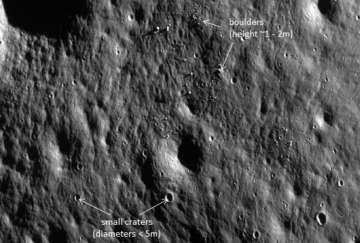The Indian Space Research Organisation shared the images of the moon surface clicked by Orbiter High-Resolution Camera (OHRC) onboard Chandrayaan-2.
ISRO shared the pictures of the moon on the micro blogging site.
The high-resolution camera onboard Chandrayaan-2 took a picture of a part of the Boguslawsky crater, located on the Moon's south pole. The camera also took close up images of the lunar surface in which several small craters and boulders are clearly seen.
"With a spatial resolution of 25 cm from a 100km orbit and a swath of 3km, the Orbiter High resolution camera provides the sharpest images ever from a lunar orbiter platform. OHRC is an important new tool for lunar topographic studies of select regions," ISRO said.
The high resolution images clicked by the OHRC was acquired on September 5 from a 100-km altitude. The image covered a part of Boguslawsky E Crater. The crater has a diameter of 14 km and a depth of 3 km. Boguslawsky E Crater lies in the southern polar area of the Moon.
Chandrayaan-2, the second lunar mission by the Indian Space Research Organisation (ISRO), failed to make a soft landing on moon (September 7) and lost connection with Vikram Lander.
Vikram Lander was just 2.1 kilometres above the lunar surface when it lost contact with ISRO, throwing a pall of gloom over the Indian space agency.
After the hard-landing of Vikram Lander on the lunar surface, the Indian Space Research Organisation (ISRO) had expressed hopes that they have at least 14 days to establish contact but hasn't been able to communicate with it so far.
National Committee of academicians and ISRO experts is analysing the cause of communication loss with VikramLander
